CONTENTS:
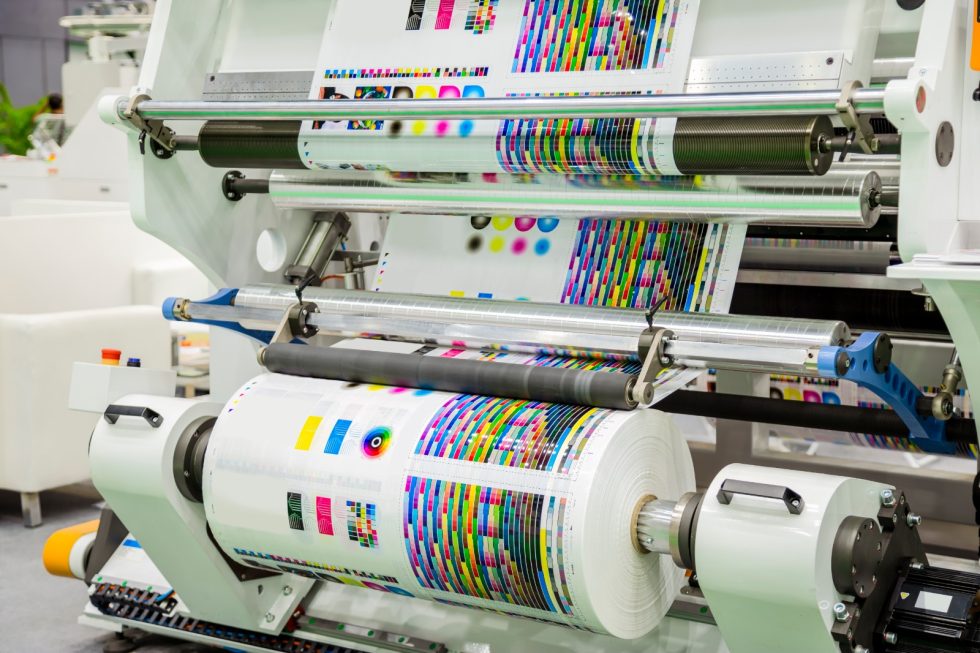
CONTENTS:
A look at the latest printing statistics shows how the landscape of professional printing continues to change and evolve.
The professional printing market once centered around putting text on paper, in the form of books, magazines, and newspapers.
This was the precursor of the Information Superhighway when information was kept with paper and ink.
Modern commercial printing is also about disseminating information, but it has taken the form of graphics and packaging, pushing the boundaries of what materials can be printed on besides paper.
Printing has transformed from newsstand products to vinyl laminated advertisements splayed across the sides of buses.
What Kind Of Printing Are We Talking About?
All kinds. Commercial printing includes traditional book and newspaper publishing as well as screen printing, flexographic printing, gravure printing, lithographic printing, and other types of package printing.
Below, we’ll look at the latest statistics on global commercial printing, the print industry in the United States, the current state of 3D printing, as well as printing in American offices.
Commercial Printing Industry Statistics
The commercial printing industry is slowly transforming from large offset printing presses to more efficient and eco-friendly printing digital printing machines.
Digital Printing Market Size From 2018 to 2030
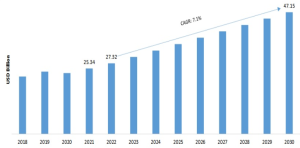
Source: Market Research Future
- In 2022, the world’s digital printing industry was worth about $27.3 billion.
- This was more than what it was worth in 2021, which was $25.3 billion.
- By the year 2030, it’s expected to grow even bigger, reaching over $47.1 billion.
- From 2022 to 2030, it should grow steadily at a rate of about 7.1% every year.
- Revenue from print advertising increased 18% between 2019 and 2020.
- North America brought in over a third (37.6%) of the digital printing industry’s money in 2022.
- Meanwhile, the Asia Pacific market is set to grow 5.7% annually until 2032.
- Print production in China fell by up to 80% during the global pandemic.
- 50% of China’s printing revenue comes from packaging.
- 30% of China’s printing market comes from traditional publishing.
- 76% of the global printing market revenue was generated by industrial printers in 2020.
United States Printing Industry Statistics
The print market in the United States has been in a continual state of decline over the last several years.
However, economists predict a growth spurt for the printing industry over the next five years, driven by business expansion.
The anticipated launch of new products and services will rely on direct mail campaigns and print advertising to support them.
- North America had the second-highest sales in commercial printing in 2022, with over 33% of the global income.
- At the same time, the US printing industry’s earnings have been dropping about 2.6% every year from 2017 to 2022.
- The industry still made $85.8 billion in 2022.
- Commercial printing generated $77.7 billion in the US in 2021.
- US print industry revenue decreased 3.4% in 2020 as a result of the COVID-19 pandemic.
- The US printing industry is declining at a faster rate than the US manufacturing industry.
- More than that, the US printing industry is declining at a faster rate than the overall United States economy.
- The US printing industry is the 14th largest manufacturing industry in America and the 147th largest industry overall.
- The US printing industry employed 396,996 in 2022, compared to 349,562 people in 2021.
- As of 2022, the US has 20,751 printing businesses, which is 1.6% less than in 2021.
- The states with the most printing businesses are California (2,909), Texas (1,638) and Florida (1,488).
- A typical American printing business employs between 7 and 8 people.
- The average of 7.6 employees per printing business increased from 2016.
- 74% of employees aged 18-34 think print is important.
- 77% of IT employees aged 18-34 think print is important.
- The revenue per employee in the US printing industry has decreased between 2016 and 2021.
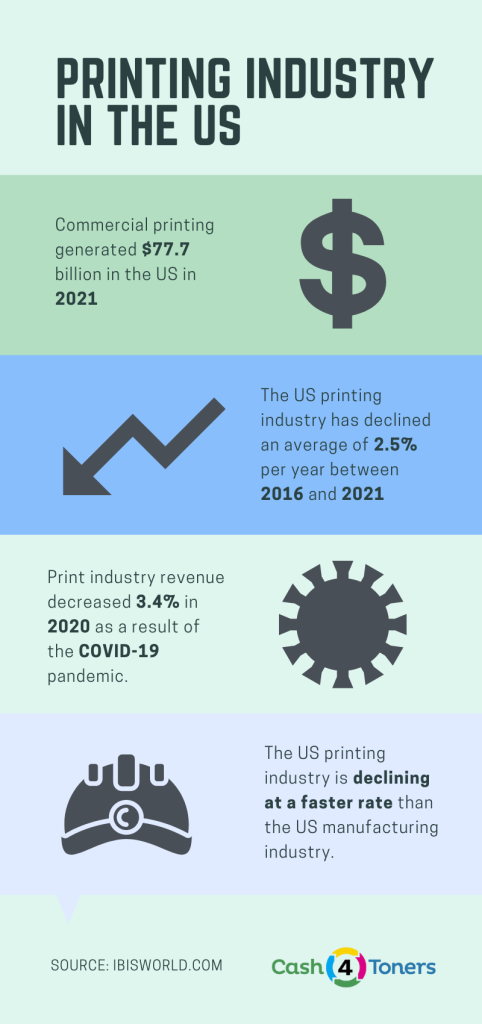
3D Printing Statistics
Unquestionably the biggest thing to hit the printer market in the last decade is 3D printers.
3D printers were once hailed as the “one to watch” by Printing Industry Trends 2015, and by 2021 the 3D printer market has grown to a nearly $14 billion industry and continues to be the fastest-growing trend in the printing market.
- The global 3D print market is expected to grow 21% annually between 2021 and 2028.
- The global 3D printing market is expected to reach a value of $37.2 billion by 2026.
- The global 3D printing market is valued at $13.7 billion in 2021.
- The global 3D printing market was valued at $12.6 billion in 2020.
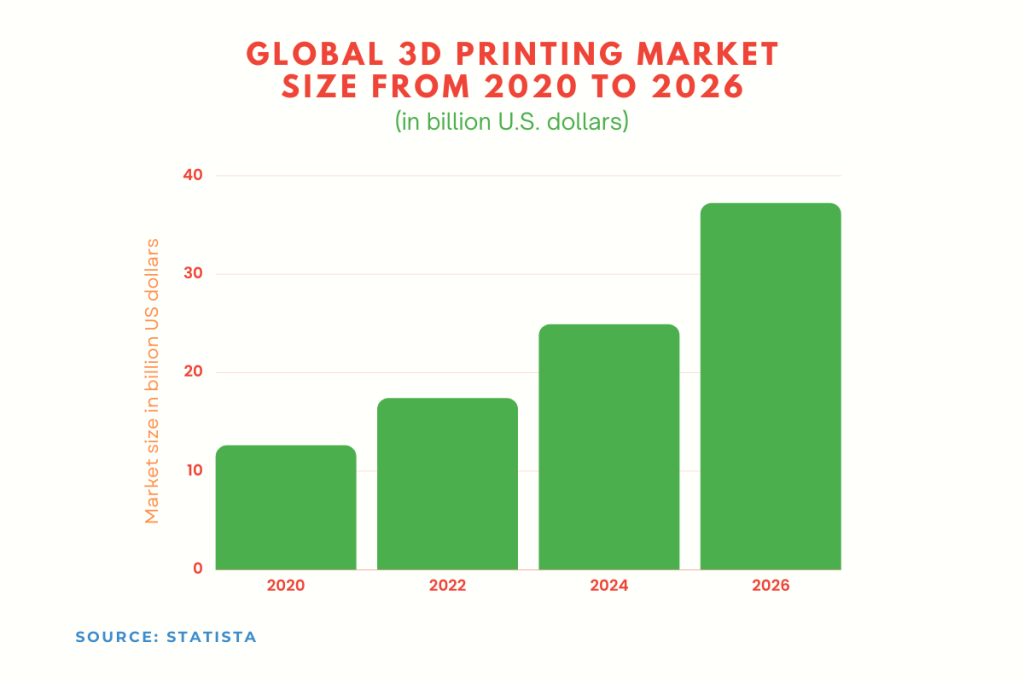
- Metal and metal alloys are the fastest-growing segment of 3D printing.
- Product development is the top priority for 3D print manufacturing.
- General Electric holds the most 3D printing patents in the US.
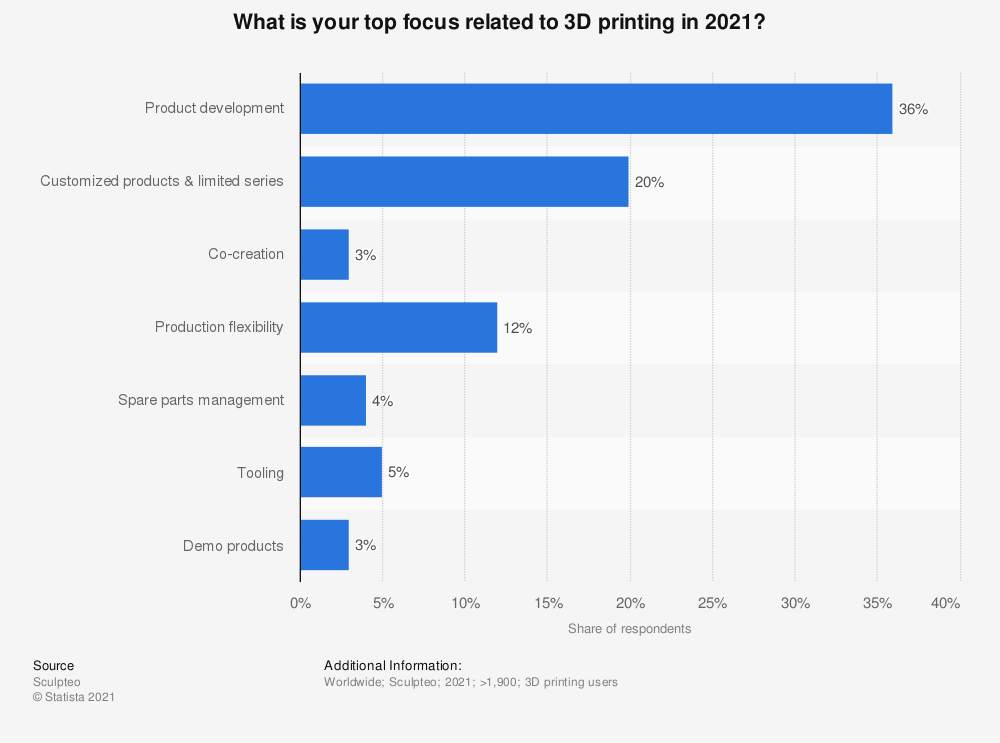
- 2.1 million 3D printers were shipped in 2020.
- 15.3 million 3D printers will be sold by 2028.
Printer Cartridges Statistics
Printer cartridges are in high demand globally, and sales figures from the US alone show just how pervasive this trend is.
Take a look at these key points:
- Each year, people use around 1.3 billion inkjet cartridges globally, with under 30% being recycled.
- In the US, over 300 million inkjet and 70 million laser cartridges are sold yearly.
- Americans throw away eight ink cartridges every second.
- Making a new toner or laser cartridge uses about a gallon of oil.
- In 2020, the market value for printing toners stood at $4.15 billion.
- It’s projected to reach $6.68 billion by 2028, with a 6.14% annual growth rate.
- Laser printers are becoming more popular than inkjets for business printing because they’re faster, waste less, offer better quality, and cost less per page.
- The rise in laser printer demand in tech-growing regions like India and China is boosting the market.
- Remanufactured toner cartridges, which cost less than brand-new ones, are quickly becoming a popular choice.
- These remanufactured cartridges, also known as extended yield cartridges, can increase printing capacity by 15-20%.
- Despite these advantages, the genuine or OEM cartridge segment is anticipated to dominate the market from 2023 to 2029.
- Customers often choose OEM cartridges for their ability to meet printing needs. Take the popular HP 414A set as an example; although it’s pricier than a remanufactured counterpart, users are likely to experience better color quality and a longer useful life.
- The ink cartridge market’s global value stands at $17,972.2 million as of 2022.
- By 2032, the market is projected to nearly double, reaching $ 34,270.6 million.
- An annual growth rate of 6.7% is expected for the market from 2022 to 2032.
Office Printing Statistics
The paperless office is a myth — employees still print a lot of pages in order to get their jobs done.
While office printing doesn’t consume raw materials like commercial printing, it can be an important cost factor for small businesses and is a good gauge for where the print vs. digital divide occurs within a company.
Your employees understand the importance of print… so keep your printer rollers clean!
- Office and home printing dropped 13.7 percent in 2020 as a result of the COVID-19 pandemic.
- 2.8 trillion pages were printed in 2020 compared to 3.2 trillion pages in 2019.
- IBM Hardware Management Console (HMC) leads the global office hardware industry with a 25.33% market share.
- 94.35 million office printers and copiers were shipped in 2019.
- Printer and copier sales increased 12 percent in 2020 to 107 million units.
- The office supply industry is expected to generate 8.2 billion by 2024.
Future Trends In Printing
By far, 3D printing is the industry’s “bold new frontier.”
The 3D market will expand exponentially as new technologies — and new materials — emerge.
Today the hot trend in 3D printing is metal and metals. What will the raw materials of 3D printing become in the future?
Atoms and molecules? Human cells? The possibilities are endless.
Meanwhile, traditional commercial printing will experience a resurgence over the next five years, as the economy rebounds from COVID-19.
Packaging will continue to be a bread-and-butter revenue stream for commercial printers.
Further reading:
- Surprising Print Advertising and Direct Mail Statistics 2021
- Eye-Opening Recycling Statistics [U.S. and Global]
- Cash4Toners Frequently Asked Questions
- Ink Saving Fonts: What Fonts Will Save You Money On Ink?
Sources
https://www.ibisworld.com/industry-statistics/market-size/printing-united-states
https://www.grandviewresearch.com/industry-analysis/3d-printing-industry-analysis
https://www.mordorintelligence.com/industry-reports/commercial-printing-market
https://www.smithers.com/services/market-reports/printing/the-future-of-global-printing-to-2024
https://quocirca.com/quocirca-state-of-the-channel-2020-executive-summary
https://www.statista.com/statistics/315386/global-market-for-3d-printers
https://www.statista.com/statistics/559749/worldwide-survey-3d-printing-top-priorities
https://www.statista.com/forecasts/1247406/worldwide-printer-and-copier-market-volume-growth
https://www.statista.com/statistics/541347/worldwide-printer-market-vendor-shares
https://www.statista.com/statistics/1127850/printed-page-volume-worldwide-home-office
https://www.ibisworld.com/industry-statistics/number-of-businesses/printing-united-states/
https://www.ibisworld.com/industry-statistics/market-size/printing-united-states/
https://www.ibisworld.com/industry-statistics/employment/printing-united-states/
https://www.futuremarketinsights.com/reports/ink-cartridge-market
https://www.grandviewresearch.com/industry-analysis/commercial-printing-market
https://www.ecyclegroup.com/recycling-facts.aspx
https://www.globenewswire.com/news-release/2020/03/05/1995813/0/en/Global-Printer-Toner-Market-Size-value-USD-7-35-Billion-by-2028-growing-at-a-CAGR-6-35-Fior-Markets.html
www.maximizemarketresearch.com/market-report/global-printing-toners-market/29162/
https://marketresearch.biz/report/printer-toner-cartridge-market/